- Sophie Main
- November 14th, 2016
In last week’s insight, They think it’s all over, we revealed why now is the time to reflect on 2016. This week, we look at why this annual act of reflection is so important and reveal how to do it effectively so that you never waste another year.
Contemplating the year gone by should be a time to celebrate all of our achievements, but it is more often used to mourn the opportunities missed and moments wasted. This may seem like a negative way to end the year, but when done effectively, it can actually be conducive to our Continuous Improvement, both personally and professionally. After all, it is only by opening our eyes to where we are going wrong that we can learn how to we can make it right.
However, looking over an entire year with a critical eye can be difficult – thick with daily routine and engrained habits, it can be hard to separate the productive from procrastination! So, to help you out, we would like to give you an early Christmas present: The gift of MUDA glasses.
MUDA glasses are not some strange new winter accessory, but the Japanese phrase for identifying waste. Waste is anything that does not add value to a process, and by identifying and removing all eight types of waste from a process, you can achieve true efficiency. So, if you want to make your 2017 as effective as possible, it’s time to put your MUDA glasses on and identify the eight wastes in your year.
What have you wasted this year?
Defects: A defect is something that is wrong or not to specification. They cost both time and energy to create and often incur the expense of rework.
Perhaps, when faced with deadlines at work this year, you rushed the finer details of a project, resulting in sub-par work that then had to be redone. Maybe your defects were closer to home, such as buying the incorrect item for a DIY job that was consequently scrapped.
The solution: The reduction of defects can be achieved by understanding the value of listening to specifications and getting it right first time.
 Overproduction: When we produce more than what is necessary, not only is the excess produce going to waste, but the resources you invested into its creation have also been wasted.
Overproduction: When we produce more than what is necessary, not only is the excess produce going to waste, but the resources you invested into its creation have also been wasted.
How many photocopies of documents have you generated this year, only to store them into a forgotten filing cabinet? How much money have you wasted buying too much food for your family, only to throw it out at the end of each week?
The solution: To avoid overproduction, you must invest time in calculating what is actually necessary.
 Waiting – Time is wasted whenever we wait idly for something to arrive from upstream in a process.
Waiting – Time is wasted whenever we wait idly for something to arrive from upstream in a process.
This waste is easy to identify and even easier to succumb too. In fact, it is likely that your year has been full of this Waste – from idly waiting for a train each morning, to procrastinating by the printer as it slowly produces your documents.
The solution: Changeover time is necessary in all areas of life and so this act of waiting is often unavoidable. However, we should always seek to reduce this time and/or use it simultaneously for a value adding activity.
 Non-Utilised talent – Potential value is wasted when people’s talents are ignored or unrecognised.
Non-Utilised talent – Potential value is wasted when people’s talents are ignored or unrecognised.
As one of the most common wastes found in organisations, it is likely that you have wasted talent this year. Whether that is leaving work feeling like your professional potential hasn’t been met or recognised, or you have not invested time in training towards a personal goal.
The solution: Make the most of your talents and skills by developing them and putting them to use. This may mean investing in training or even trying a new career.
 Transport – Although often necessary, there is no value added to products when they are transported. For this reason, it is considered a waste when we add unnecessary transportation.
Transport – Although often necessary, there is no value added to products when they are transported. For this reason, it is considered a waste when we add unnecessary transportation.
In terms of business, if parts are being transported from a factory at the other end of the country as opposed to a closer supplier, this is quite clearly a waste. But, if we look closely, the waste of transport may also evident in our daily lives. For example, consider the supermarket you have gone to over the last year – could you have been stocking your cupboards from one closer to home?
The solution: Reevaluate the way you transport goods and question whether there are more efficient routes or suppliers for your needs.
 Inventory – Inventory is any excess material or unfinished work. The creation of inventory has cost time and money but, as they are incomplete, they are of no value.
Inventory – Inventory is any excess material or unfinished work. The creation of inventory has cost time and money but, as they are incomplete, they are of no value.
Consider all the projects you began this year that you are yet to complete: The materials you sourced to redecorate your bathroom; the novel you stopped writing; the business you began to set-up. Whatever it is, if the project is currently incomplete then all the time, money, and effort spent on it so far is waste.
The solution: Organising your time, prioritising your projects, and issuing resources effectively will reduce the waste of inventory.
 Motion – This is the unnecessary additional movement of people and produce.
Motion – This is the unnecessary additional movement of people and produce.
This waste often occurs through poor planning, particularly in relation to space. From the factory floor to your kitchen layout, additional movement is incurred if it is not positioned and arranged logically. This motion creates costs both energy and time, and as time is money, if it the waste of motion is present in a business it will also accumulate a financial cost.
The solution: Identify unnecessary motion in your life by looking at processes and procedures, such as your journey to work or the layout of your workspace, with fresh eyes and a logistical approach.
 Excess Processing – This waste occurs when we spend time, expend energy, and invest money in adding more detail than is necessary.
Excess Processing – This waste occurs when we spend time, expend energy, and invest money in adding more detail than is necessary.
We are often encouraged to go the extra mile, but when that additional investment adds no value, then it is a waste. So, that unnecessary errand you run each morning for your boss, if it is going unnoticed and adds no real value, then perhaps it’s time you spend that energy on something that does add value – something that will get you noticed.
The solution: Before commencing a project or task, take time to define the level of detail that is actually required.
After identifying where you are generating waste in your year, it’s time to remove it. While the removal of waste isn’t always easy, requiring the breaking of bad habits and the ability to embrace change, the results will be worth it; you will be more efficient and effective, and ready to make 2017 the best year yet. What’s more, once you are able to identify waste in one process, you can apply it to all industries or areas of life – so Muda glasses really are the gift that keeps on giving!
If you would like to learn more about Lean practices such as the removal of waste or want to prepare for next year by gaining tools to achieve full efficiency, then Lean Six Sigma training is for you. To get started, just click the button below and take our online introductory Lean Six Sigma course – it’s FREE, quick and completely online, so it certainly won’t be a waste!

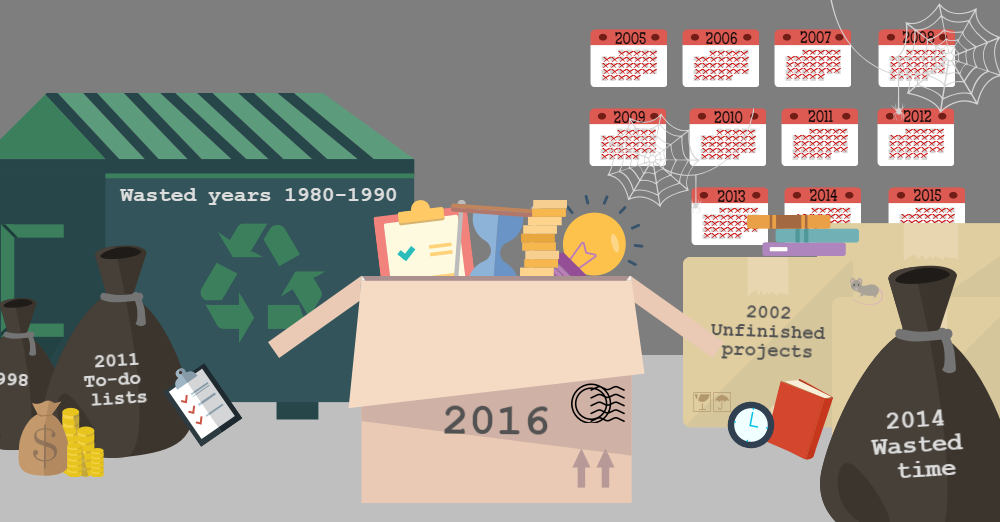

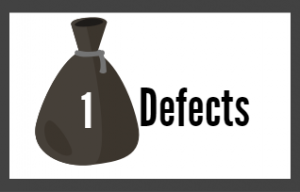
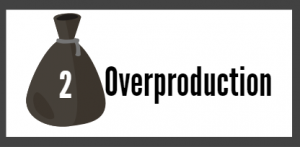 Overproduction: When we produce more than what is necessary, not only is the excess produce going to waste, but the resources you invested into its creation have also been wasted.
Overproduction: When we produce more than what is necessary, not only is the excess produce going to waste, but the resources you invested into its creation have also been wasted.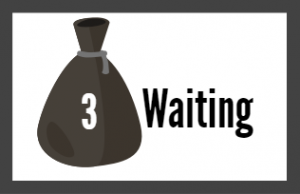 Waiting – Time is wasted whenever we wait idly for something to arrive from upstream in a process.
Waiting – Time is wasted whenever we wait idly for something to arrive from upstream in a process.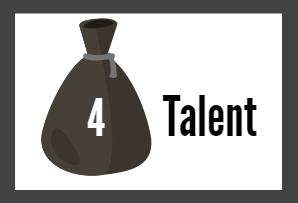 Non-Utilised talent – Potential value is wasted when people’s talents are ignored or unrecognised.
Non-Utilised talent – Potential value is wasted when people’s talents are ignored or unrecognised.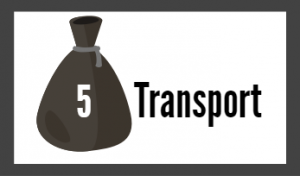 Transport – Although often necessary, there is no value added to products when they are transported. For this reason, it is considered a waste when we add unnecessary transportation.
Transport – Although often necessary, there is no value added to products when they are transported. For this reason, it is considered a waste when we add unnecessary transportation.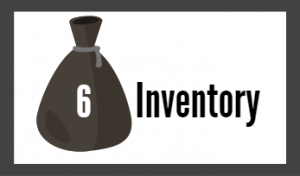 Inventory – Inventory is any excess material or unfinished work. The creation of inventory has cost time and money but, as they are incomplete, they are of no value.
Inventory – Inventory is any excess material or unfinished work. The creation of inventory has cost time and money but, as they are incomplete, they are of no value. Motion – This is the unnecessary additional movement of people and produce.
Motion – This is the unnecessary additional movement of people and produce.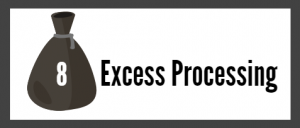 Excess Processing – This waste occurs when we spend time, expend energy, and invest money in adding more detail than is necessary.
Excess Processing – This waste occurs when we spend time, expend energy, and invest money in adding more detail than is necessary.
